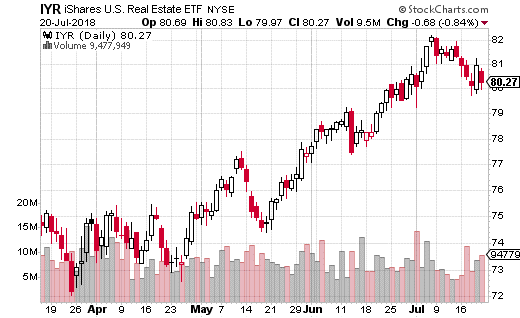I don’t spend a lot of time writing about real estate in this space. It’s not that it isn’t important, in fact it’s quite the opposite. Of all the sectors most impacted by a change in interest rates, real estate is at the top of the list.
However, I just don’t find real estate that interesting compared to options trading. Housing prices tend to be slow moving, and unlike options trading, there just isn’t a lot of action involved with investing in the real estate market. However, what if we combined the two areas… real estate and options trading? Now we’re talking about a topic I can relate to.
Of course, we can’t trade options on individual mortgages – and derivative trading on groups of mortgages is generally an OTC market limited to institutions. (Let’s not even mention that derivative trading on mortgages is a big reason why we had the financial crisis of 2008-2009.)
Fortunately, ETFs have emerged which allow investors and traders to get easily involved with real estate and mortgages. REITs tend to focus more on the mortgage side of things, while real estate ETFs often invest in stocks such as homebuilders and storage companies, as well as REITs.
Probably the most popular real estate ETF is iShares Dow Jones US Real Estate ETF (NYSE: IYR). IYR trades over 8 million shares a day on average and almost 20,000 options. As you can see from the chart, IYR has done very well the last few months (in line with the overall real estate market).

However, could real estate – especially housing prices – be in trouble in the coming months? Higher interest rates generally slow or stall the increase in housing prices (due to more expensive mortgages). Are expected rate increases going to derail the bull market in housing?
Let’s look at the options market for clues…
A large trade in IYR last week could suggest the real estate sector could take a downturn by the beginning of 2019. Or, perhaps a big investor is hedging his or her exposure to real estate. Either way, it’s worth paying attention to this trade.
More specifically, the trader bought a large put spread in January 2019 options with IYR at $80.60. The trader spent $1.15 to buy the 72-77 put spread (buying the 77 strike, selling the 72) strike a total of 15,000 times for a cost of $1.7 million. Max loss on a debit spread like this is simply the premium paid, aka the cost of the spread.
The breakeven for the trade is at $75.85 (77 long strike minus the cost of trade or $1.15). Max gain is at $72 or below by expiration and is the spread width (5) minus the cost of $1.15, or $3.85. In total dollar terms, the trader can make $5.8 million on the trade.
Whether this is a hedge against a long position or a bet that IYR is going lower, it is quite a lot to spend. Someone is, at the very least, concerned that IYR could lose 10% by early next year. That would be a pretty sizeable down move in the real estate market. If you have similar concerns or believe housing prices are going to peak in the next few months, this is a reasonable way to get almost six months of time for the thesis to play out.
[FREE REPORT] Options Income Blueprint: 3 Proven Strategies to Earn More Cash Today Discover how to grab $577 to $2,175 every 7 days even if you have a small brokerage account or little experience... And it's as simple as using these 3 proven trading strategies for earning extra cash. They’re revealed in my new ebook, Options Income Blueprint: 3 Proven Strategies to Earn Extra Cash Today. You can get it right now absolutely FREE. Click here right now for your free copy and to start pulling in up to $2,175 in extra income every week.
Source: Investors Alley
